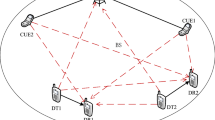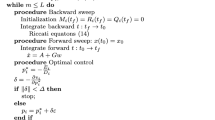Abstract
In this paper, we formulate a sum-rate maximization problem for device-to-device (D2D) communications underlaying downlink multiple-input multiple-output heterogenous cellular networks subject to the quality of service constraints and the interference temperature constraint. Since it is difficult to obtain the optimal solution due to the high complexity, game theory is used to study the resource allocation in such networks. The proposed game is a potential game where the existence of Nash equilibrium (NE) is guaranteed. A practical resource allocation algorithm based on better response dynamic is proposed. We prove that the proposed algorithm can converge to a feasible NE. Numerical results show that the proposed algorithm can achieve near optimal sum rate performance with low complexity.




Similar content being viewed by others
References
Lin, X., Andrews, J. G., Ghosh, A., & Ratasuk, R. (2014). An overview of 3GPP device-to-device proximity services. IEEE Communications Magazine, 52(4), 40–48.
Feng, D., Lu, L., Wu, Y. Y., Li, G. Y., Li, S., & Feng, G. (2014). Device-to-device communications in cellular networks. IEEE Communications Magazine, 52(4), 49–55.
Phunchongharn, P., Hossain, E., & Kim, D. I. (2013). Resource allocation for device-to-device communications underlaying LTE-advanced networks. IEEE Wireless Communications, 20(4), 91–100.
Xu, C., Song, L., & Han, Z. (2013). Resource management for device-to-device underlay communication. Berlin: Springer. Briefs in Computer Science Series.
Zhu, D., Wang, J., Swindlehurst, A. L., & Zhao, C. (2014). Downlink resource reuse for device-to-device communications underlaying cellular networks. IEEE Signal Processing Letters, 21(5), 531–534.
Li, J. C., Lei, M., & Gao, F. (2012). Device-to-device (D2D) communication in MU-MIMO cellular networks. In Proceedings of IEEE GLOBECOM (pp. 3583–3587).
Tang, H., Zhu, C., & Ding, Z. (2013). Cooperative MIMO precoding for D2D underlay in cellular networks. In Proceeding of IEEE international conference on communications (ICC) (pp. 5517–5521).
Janis, P., Koivunen, V., Ribeiro, C. B., Doppler, K., & Hugl, K. (2009). Interference-avoiding MIMO schemes for device-to-device radio underlaying cellular networks, in Proc (pp. 2385–2389). Indoor and mobile radio communications: IEEE international symposium on personal.
Dhillon, H. S., Kountouris, M., & Andrews, J. G. Downlink MIMO HetNets: modeling, ordering results and performance analysis, IEEE Transaction on Wireless Communications. arXiv:1301.5034.
Zhang, R., Liang, Y. C., & Cui, S. (2010). Dynamic resource allocation in cognitive radio networks. IEEE Signal Processing Magazine, 27(3), 102–114.
Love, D. J., & Heath, R. W, Jr. (2005). Multimode precoding for MIMO wireless systems. IEEE Transactions on Signal Processing, 53(10), 3674–3687.
Xing, Y., & Chandramouli, R. (2008). Stochastic learning solution for distributed discrete power control game in wireless data networks. IEEE/ACM Transactions on Networking, 16(4), 932–944.
Zhong, W., & Wang, J. (2013). Energy efficient discrete spectrum sharing strategy selection in cognitive MIMO interference channels. IEEE Transactions on Signal Processing, 61(14), 3705–37017.
Zhong, W., Xu, Y., & Huaglory, T. (2011). Game-theoretic opportunistic spectrum sharing strategy selection for cognitive MIMO multiple access channels. IEEE Transactions on Signal Processing, 59(6), 2745–2759.
Cumanan, K., Zhang, R., & Lambotharan, S. (2012). A new design paradigm for MIMO cognitive radio with primary user rate constraint. IEEE Communications Letters, 16(5), 706–709.
Zhong, W., Fang, Y., Jin, S., Wong, K. K., Zhong, S., & Qian, Z. (2015). Joint resource allocation for device-to-device communications underlaying uplink MIMO cellular networks. IEEE Journal on Selected Areas in Communications, 33(1), 41–54.
Monderer, D., & Shapley, L. S. (1996). Potential games. Games and Economics Behaviour, 14, 124–143.
Myerson, R. (1991). Game theory: Analysis of conflict. Cambridge and London: Harvard University Press.
3GPP TS 36.211 v8.4.0 Evolved universal terrestrial radio access (E-UTRA); Physical channel and modulation (Release 8)[S] 2008.
Acknowledgments
This work is supported by the National Nature Science Foundation of China under Grant 61201218 and 61201241, and by the Jiangsu Province Natural Science Foundation under Grant BK2012056, and by the Project funded by China Postdoctoral Science Foundation under Grant Nos. 2013M532207 and 2014T70966.
Author information
Authors and Affiliations
Corresponding author
Rights and permissions
About this article
Cite this article
Zhong, W., Fang, B. & Qian, Z. Game Theoretic Resource Allocation for D2D MIMO Heterogenous Networks. Wireless Pers Commun 84, 273–285 (2015). https://doi.org/10.1007/s11277-015-2607-8
Published:
Issue Date:
DOI: https://doi.org/10.1007/s11277-015-2607-8




